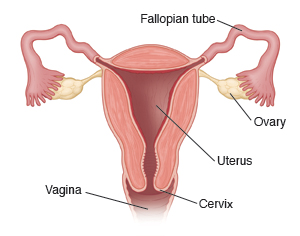Pelvic Pain, Uncertain Cause

Pelvic pain is pain felt in the lowest part of the belly (abdomen) and between the hipbones. The pain may occur suddenly and recently (acute). Or the pain may last for 6 months or longer (chronic).
There are many possible causes of pelvic pain. The pain may be from a problem in the female reproductive system. Or it may be from a problem in the digestive, urinary, or musculoskeletal systems.
Based on your visit today, the exact cause of your pelvic pain is not certain. Your condition doesn't seem to be serious at this time. But it is important for you to keep watching for any new symptoms or worsening of your condition.
General care
Your doctor may advise a number of ways to help manage your pain. These can include:
-
Taking over-the-counter pain medicine. Stronger pain medicine may also be prescribed, if needed.
-
Applying heat to the pelvic area. Use a heating pad or a hot pack. Taking a hot bath may also help.
-
Getting plenty of rest.
-
Making certain lifestyle changes. These can include practicing good posture and getting regular exercise. Studies have shown that these changes help reduce pelvic pain in some people.
-
Seeing a physical therapist or pain specialist. These health care providers can discuss other ways to manage pain with you.
-
Using acupressure or acupuncture.
Follow-up care
Follow up with your doctor as advised.
When to get medical advice
Contact your doctor right away if you have:
-
Fever of 100.4°F (38°C) or higher, or as directed by your doctor.
-
Pain that gets worse or you have sudden, severe pain or new pain.
-
Nausea, vomiting, sweating, or restlessness.
-
Dizziness or fainting.
-
Abnormal vaginal discharge.
-
Abnormal vaginal bleeding (especially bleeding after menopause).
Online Medical Reviewer:
Heather M Trevino BSN RNC
Online Medical Reviewer:
Tennille Dozier RN BSN RDMS
Date Last Reviewed:
7/1/2025
© 2000-2025 The StayWell Company, LLC. All rights reserved. This information is not intended as a substitute for professional medical care. Always follow your healthcare professional's instructions.